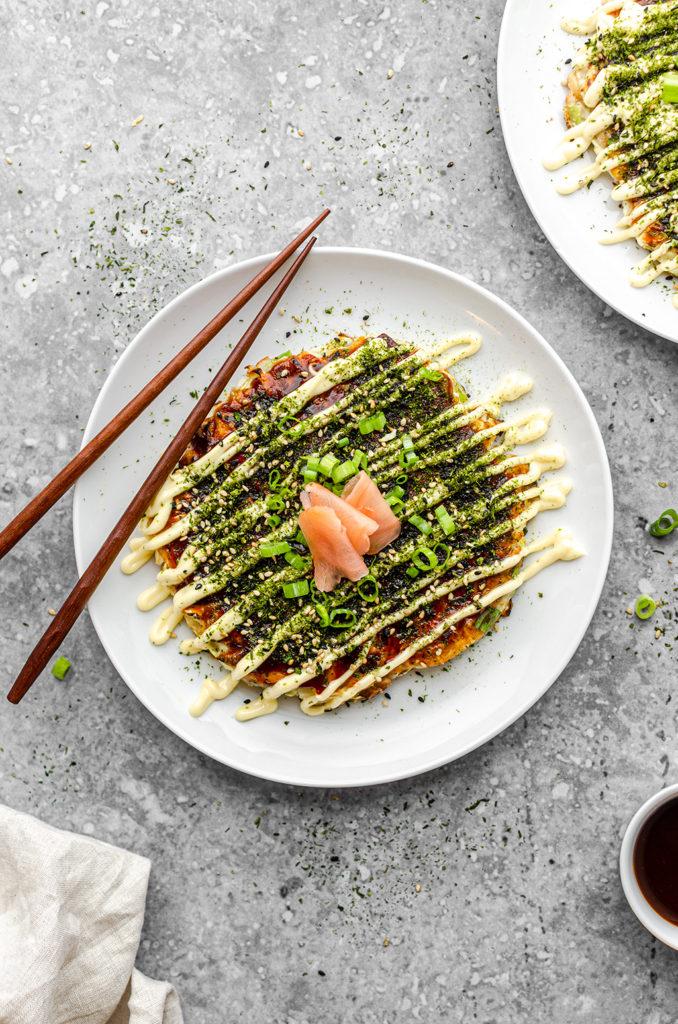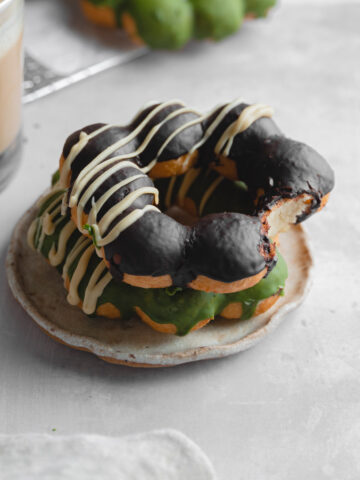Vegan Okonomiyaki, A.K.A. Japanese pancake or Japanese pizza is a delicious savory dish. This dish loaded with vegetables, like cabbage, shiitake mushrooms, green onions, and a very special root vegetable. This recipe is not only delicious, but it’s also pretty healthy-ish. I’ve adapted this recipe to make it vegan friendly, while keeping true to the authenticity.

This dish is quite a popular street food in Osaka, Japan. I have visited Osaka, and when I went to Dōtonbori (a tourist hotspot), there were a lot of places that were cooking okonomiyaki. The smell of the food mixing together, fills the street with the most flavorful aromas ever. It will definitely keep you hungry. Now, there are also two versions of okonomiyaki, the Osaka version, like I’ve mentioned and a Hiroshima style. This recipe will focus solely on the Osaka style.

I’ve actually made okonomiyaki before, this was when I took Japanese class for a couple years. And as a fun thing to do, our sensei taught us how to make it, keep in mind that this was way before I ever became plant-based. The original recipe is not vegan friendly, but it is very adaptable. I was able to create this recipe using plant-based ingredients and it tastes just as amazing as I remembered it to be.

Key Ingredients:
- Nagaimo/Yamaimo is a Japanese mountain yam that is the most important ingredient to make this fluffy and chewy dish. When grated, it gets really slimy, which I find weirdly fascinating. This also acts as a binder, since it has the consistency of eggs. My top tip is to wear a glove while you grate this, it will be hard to hold because of how slimy it is.
- Kombu & Dried Shiitake Mushrooms. These two combined in boiling water will make a vegan dashi, full of umami flavor. Dashi is a stock that is used in Japanese cuisine. The most common one is made with bonito, which is a thinly sliced dried fish.
- Okonomiyaki Sauce. You can buy okonomiyaki sauce in stores, but if you cannot find it, you can also make it. Without this sauce, the dish will definitely be incomplete and lacking a lot of flavor. This is the okonomiyaki sauce: https://amzn.to/2XxMDeZ
- Japanese mayo. I have yet to find a vegan Japanese mayo, so I decided to try and make it for myself. The combination of flavors from both the sweet savory from the okonomiyaki sauce and the creamy and tangy mayo is very common in Japanese cuisine, and it’s delicious. I have created my own version of Japanese mayo, and it might not be exactly the same, I think it’s the closest I can get. I do not suggest using American style mayo as the flavors are not the same.

If you’d tried this recipe out let me know in the comments! Don’t forget to follow me on Instagram @flouredframe and don’t forget to tag me when you create my recipes! Happy cooking!
As an Amazon Associate I earn from qualifying purchases.
📖 Recipe

Vegan Okonomiyaki
Equipment
- Small saucepan
- Fine mesh sieve
- Mixing bowls
- Whisk
- Chopping Board
- Knife
- Kitchen gloves
- Box grater
- Large pan
Ingredients
Dashi:
- 5 pieces Kombu (cut down into 2-inch sizes)
- 5 pieces Dried shiitake
- 1 teaspoon Mushroom seasoning (optional, adds more flavor)
- ⅓ cup Water
Vegan Japanese Style Mayo:
- 1 cup Vegan mayo
- 2 tablespoons Mirin
- 3 tablespoons Agave
- ¾ teaspoon Indian black salt (Kala namak, see notes)
- 2 teaspoons Mustard
Okonomiyaki sauce:
- 1 ½ tablespoons Agave
- 2 tablespoons Vegan oyster sauce
- 4 tablespoons Ketchup
- 3 ½ tablespoons Vegan worcestershire sauce
Main Ingredients:
- 2 cups (190g) Cabbage (thinly cut and cut into ½ inch pieces)
- 1 cup (75g) Fresh shiitake mushrooms (thinly sliced)
- 2 Stalks of green onions (more for topping, thinly sliced)
- ½ cup (64g) All purpose flour
- ¼ teaspoon Salt
- ¼ teaspoon Sugar
- ¼ teaspoon Baking powder
- 2 inches (80g) Japanese mountain yam (Nagaimo/yamaimo, see notes)
- ½ cup Tempura scraps (Tenkasu/agedama, optional, see notes)
- 2 tablespoons Pickled red ginger (Beni shōga, optional)
- 3 pieces Vegan bacon (optional, see notes)
- Oil (for frying)
- Furikake (Seaweed seasoning)
Instructions
Dashi and sauces (These can be made a day ahead):
- Dashi: Heat water along with kombu, dried shiitake, and mushroom seasoning in a small saucepan. Bring it to a boil, then turn the heat off, and allow the kombu and dried shiitake to steep for 10 minutes. Drain the dashi into the bowl and discard the rest, set aside.
- In a small bowl, combine all the ingredients for the Vegan Japanese-style mayonnaise. In another bowl, combine all the ingredients for the okonomiyaki sauce. Set these aside until ready to use.
Okonomiyaki:
- Prep the cabbage, shiitake mushrooms, and green onions. Defrost your vegan bacon, and cut them in half. Set aside.
- In a bowl, mix together the dry ingredients, flour, salt, sugar, and baking powder.
- While wearing kitchen gloves, peel and grate 2 inches of the mountain yam over the same bowl with the dry ingredients. Measure out ¼ cup of dashi and add it to the bowl, mix the ingredients together with a whisk until fully combined.
- Next, add in the cabbage, shiitake mushrooms, green onions, tempura scraps, and pickled red ginger and mix it all together.
- Heat a little bit of oil in a large pan over medium heat. When the oil is ready, add half of the batter to the pan. Spread it out to about 6 inches in diameter and ½-3/4 inch thickness, and form into a circle. Add 3 pieces of vegan bacon to the top, and pressing it down slightly to stick. Cook the bottom until nicely browned, about 5 minutes. Flip over and cook for another 5 minutes. Remove from the pan, and onto a plate. Continue cooking the second batch of batter.
- Spread the okonomiyaki sauce over the top of the pancake, then drizzle some vegan Japanese-style mayonnaise, and top it off with some furikake and green onions. Cut into quarters and serve.
Notes
- Kombu comes in various sizes, so just break it into smaller pieces.
- I like adding the mushroom seasoning because it adds so much more flavor and it enhances the flavors of the dashi. If you cannot find it, you can skip this ingredient.
- I highly suggest making my Japanese-style mayo, it will be a little bit looser than normal, but it tastes the closest to Japanese mayonnaise. If you really don’t want to make it, you can use American mayo, but keep in mind that the flavors are completely different.
- Indian black salt or Kala Namak, is a salt that is sulphurous, pungent-smell. It makes certain vegan dishes taste like eggs, which is perfect for this mayo. Do not skip.
- Japanese mountain yam is a very stick yam, especially when cut or peeled. When grated, it creates this extremely bubbly sticky texture, that kind of resembles egg whites. This is what is used to bind these ingredients together in this recipe. So extra careful when grating, please use kitchen gloves! You can find these in most Asian grocery stores.
- You can find premade tempura scraps in your local Asian supermarket, be sure to check the ingredients as some will contain eggs. It adds texture, flavor, and fluffiness to the okonomiyaki.
- I like adding vegan bacon to this because I wanted to recreate the traditional style where they added pork slices. It adds a great smokey flavor to the dish.





Amy Doolittle says
I’m the organizer of the longest running vegan food swap meetup in the US (possibly on the continent) and for this latest meetup, I decided to make your okonomiyaki—was going to do the takoyaki but couldn’t find the pan at all the Asian markets in Philadelphia—for 9 people plus a large tasting portion for the table. Here are some notes from the experience:
First, I am amazed by the Japanese mountain yam! The viscosity is unreal, and thank you for the suggestion to wear gloves. It shredded fine with the small hole shredder of the food processor. I’m going to experiment more with this amazing tuber, even if it is pricier than JustEgg.
Second, recipe glitch: In the ingredients, you listed baking powder as a mild leavening agent.. In the instructions, you list it as baking soda. I went with the baking powder, and it turned out fine, though you probably should prevent heart attacks and fix the error.
Third, my better-than-I-deserve mate makes my mayonnaise using chickpea brine and oil. For some reason, the additions to the mayo caused it to become significantly less thick, almost a watery cream. Is that texture similar to Japanese mayonnaise?
Last, I doubled this recipe and fed the equivalent of 14 people. The size of the pancakes were about 6”, and I had both leftover Japanese mayonnaise and okonomiyaki sauce. Should any of your readers choose to multiply the recipe, kindly keep this in mind.
Thank you once again for your explorations of vegan cuisine and for posting these amazing recipes! I’ll keep my eyes out for the right pan for takoyaki. And if you’re ever in Philly on the first Monday night of the month, come to Food Swap!